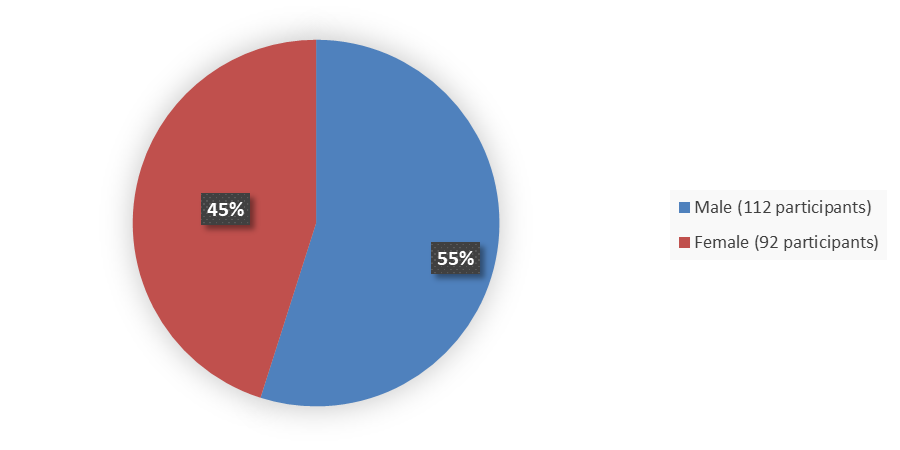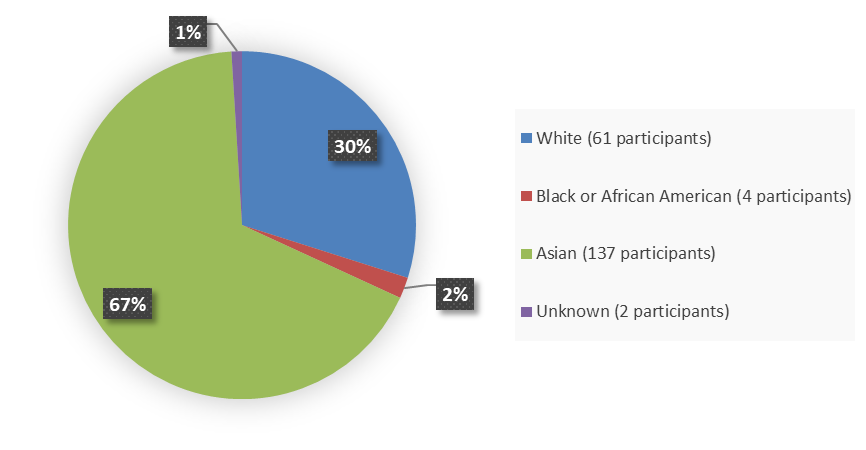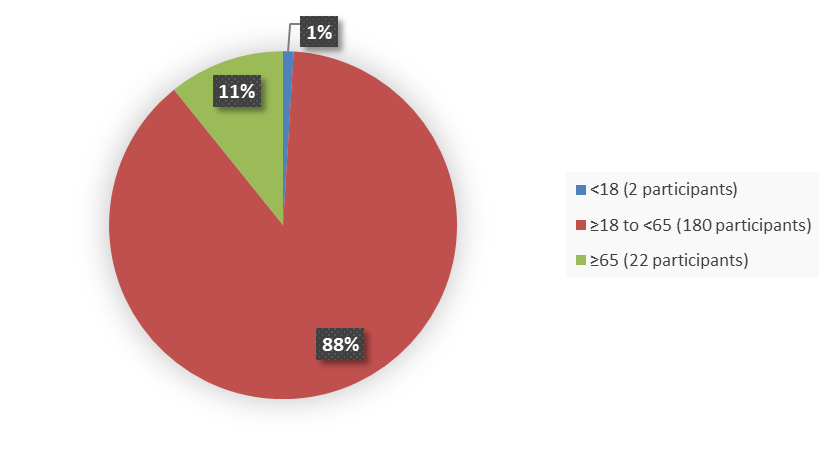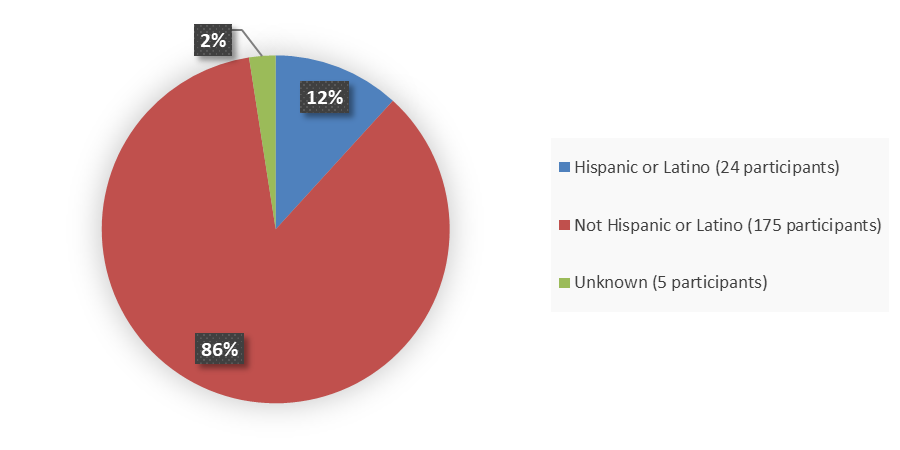Drug Trials Snapshots: PIASKY
HOW TO USE THIS SNAPSHOT
The information provided in Snapshots highlights who participated in the key clinical trials that supported the original FDA approval of this drug, and whether there were differences among sex, race, age, and ethnic groups. The “MORE INFO” bar shows more detailed, technical content for each section. The Snapshot is intended as one tool for consumers to use when discussing the risks and benefits of the drugs.
LIMITATIONS OF THIS SNAPSHOT:
Do not rely on Snapshots to make decisions regarding medical care. Always speak to your healthcare provider about the benefits and risks of a drug.
Some of the information in this Snapshot is for presentation purposes and does not represent the approved conditions of use of this drug. Refer to the PIASKY Prescribing Information for all of the approved conditions of use of this drug (e.g., indication(s), population(s), dosing regimen(s), safety information).
Snapshots are limited to the information available at the time of the original approval of the drug and do not provide information on who participated in clinical trials that supported later approvals for additional uses of the drug (if applicable).
PIASKY (crovalimab-akkz)
pea-UH-sky
Genentech, Inc.
Original Approval date: June 20, 2024
DRUG TRIALS SNAPSHOT SUMMARY:
What is the drug for?
PIASKY is a prescription drug that is a complement C5 inhibitor used to treat adult and pediatric patients 13 years and older with a disease called paroxysmal nocturnal hemoglobinuria (PNH) and body weight of at least 40 kg.
PNH is a serious, life-threatening disease which is characterized by destruction of red blood cells (hemolysis), blood clots (thrombosis), and bone marrow dysfunction due to the overactivation of the complement system, a part of the body’s immune system.
How is this drug used?
PIASKY is given by a healthcare provider directly into the bloodstream through a needle in the vein (known as an intravenous or IV infusion) on Day 1, followed by doses given under the skin (subcutaneously) weekly for four times on Days 2, 8, 15, 22, and then every four weeks starting on Day 29.
Who participated in the clinical trials?
The FDA approved PIAKSY based on evidence from one clinical trial (COMMODORE 2, NCT04434092) that enrolled 204 patients with PNH and body weight of at least 40 kg who were not previously treated with a complement inhibitor. The trial was conducted at 66 sites in 25 countries in Asia, Europe, Central, South, and North America (no patients were enrolled in the United States).
Safety was assessed from two clinical trials (COMMODORE 2 and COMMODORE 1, NCT04432584). COMMODORE 1 enrolled 86 patients with PNH and body weight of at least 40 kg switching from eculizumab (another approved C5 inhibitor) at 52 sites in 20 countries in Asia, Europe, Central, South, and North America (no patients were enrolled in the United States).
The number of patients representing efficacy findings differs from the number of patients representing safety findings due to different pools of study participants analyzed for efficacy and safety.
How were the trials designed?
COMMODORE 2 was a randomized, active-controlled, open-label clinical trial that enrolled patients with PNH who were complement inhibitor naïve. The benefit of PIASKY in comparison to eculizumab was assessed by hemolysis control and transfusion avoidance.
COMMODORE 1 was a randomized, active-controlled, open-label clinical trial that enrolled patients with PNH switching from another C5 inhibitor therapy.
In both trials, patients received either PIASKY or eculizumab for 24 weeks, after which patients had the option to continue or switch to PIASKY in an extension period.
How were the trials designed?
The efficacy of PIASKY was evaluated in one clinical trial (COMMODORE 2) and safety in two clinical trials (COMMODORE 2 and COMMODORE 1).
COMMODORE 2 was an active-controlled, open-label, non-inferiority study that randomized 204 patients with PNH who were not previously treated with a complement inhibitor to receive either PIASKY (n=135) or eculizumab (n=69). The study additionally enrolled six pediatric patients (aged >12 years and body weight ≥40 kg) who received PIASKY in a separate cohort. The co-primary endpoints were hemolysis control, as measured by the mean proportion of patients with lactate dehydrogenase (LDH) ≤1.5x the upper limit of normal (ULN) from Week 5 to Week 25; and the proportion of patients who achieved transfusion avoidance, defined as patients who were packed red blood cell (pRBC) transfusion-free, from Baseline through Week 25. COMMODORE 1 was an active-controlled study that randomized 86 patients with PNH switching from another C5 inhibitor therapy (i.e., eculizumab) to receive either PIASKY (n=44) or eculizumab (n=42).
In both trials, a single IV loading dose of PIASKY was given on Day 1 (1,000 mg for patients weighing ≥40 kg to <100 kg, or 1,500 mg for patients weighing >100 kg), followed by four additional weekly subcutaneous loading doses of 340 mg on Days 2, 8, 15, and 22. Starting at Day 29, maintenance subcutaneous doses were given every four weeks (680 mg for patients weighing ≥40 kg to <100 kg, or 1,020 mg for patients weighing ≥100 kg).
DEMOGRAPHICS SNAPSHOT
Figure 1 summarizes how many males and females were enrolled in the COMMODORE 2 clinical trial.
Figure 1. Baseline Demographics by Sex, Efficacy Population
Source: Adapted from FDA Review
Figure 2 summarizes how many patients by race were enrolled in the COMMODORE 2 clinical trial.
Figure 2. Baseline Demographics by Race, Efficacy Population
Source: Adapted from FDA Review
Figure 3 summarizes how many patients by age were enrolled in the COMMODORE 2 clinical trial.
Figure 3. Baseline Demographics by Age, Efficacy Population
Source: Adapted from FDA Review
Figure 4 summarizes how many patients by ethnicity were enrolled in the COMMODORE 2 clinical trial.
Figure 4. Baseline Demographics by Ethnicity, Efficacy Population
Source: Adapted from FDA Review
Who participated in the trials?
Baseline demographics for COMMODORE 2 are presented in Table 1.
Table 1. Baseline Demographics of Efficacy Trials, COMMODORE 2
|
Demographic |
PIASKY (Naïve) |
Eculizumab (Naïve) |
Total |
|---|---|---|---|
|
Sex, n (%) |
|||
|
Male |
77 (57.0) |
35 (50.7) |
112 (54.9) |
|
Female |
58 (43.0) |
34 (49.3) |
92 (45.1) |
|
Age, years |
|||
|
Mean (SD) |
40.5 (15.2) |
41.9 (16.0) |
41 (15.5) |
|
Median (min, max) |
36 (18, 76) |
38 (17, 78) |
36.5 (17, 78) |
|
Age group, years, n (%) |
|||
|
<18 |
0 |
2 (2.9) |
2 (1.0) |
|
≥18 to <65 |
122 (90.4) |
58 (84.1) |
180 (88.2) |
|
≥65 |
13 (9.6) |
9 (13.0) |
22 (10.8) |
|
Age group ≥75, years, n (%) |
|||
|
≥75 |
2 (1.5) |
2 (2.9) |
4 (2.0) |
|
Race, n (%) |
|||
|
Asian |
86 (63.7) |
51 (73.9) |
137 (67.2) |
|
White |
45 (33.3) |
16 (23.2) |
61 (29.9) |
|
Black or African American |
3 (2.2) |
1 (1.4) |
4 (2.0) |
|
Unknown |
1 (0.7) |
1 (1.4) |
2 (1.0) |
|
Ethnicity, n (%) |
|||
|
Hispanic or Latino |
18 (13.3) |
6 (8.7) |
24 (11.8) |
|
Not Hispanic or Latino |
114 (84.4) |
61 (88.4) |
175 (85.8) |
|
Not reported |
3 (2.2) |
2 (2.9) |
5 (2.5) |
|
Weight (kg) |
|||
|
Median (min, max) |
66 (12, 140) |
62 (47, 122) |
65 (12, 140) |
|
Weight category, kg, n (%) |
|||
|
40 to <100 |
131 (97.0) |
66 (95.7) |
197 (96.6) |
|
≥100 |
4 (3.0) |
3 (4.3) |
7 (3.4) |
|
Region, n (%) |
|||
|
Asia |
85 (63.0) |
51 (73.9) |
136 (66.7) |
|
Europe |
36 (26.7) |
12 (17.4) |
48 (23.5) |
|
Central and |
12 (8.8) |
2 (2.9) |
14 (6.9) |
|
North America |
2 (1.5) |
4 (5.8) |
6 (2.9) |
Source: Adapted from FDA Review
Abbreviations: SD, standard deviation
What are the benefits of this drug?
COMMODORE 2 compared the need for blood transfusions and hemolysis control between PIASKY and eculizumab (a drug used to treat PNH). The trial cannot show whether one treatment is better than the other, but patients treated with PIASKY achieved results that were as good as those in patients treated with eculizumab.
What are the benefits of this drug (results of trials used to assess efficacy)?
Efficacy results from COMMODORE 2 are summarized in Table 2. The co-primary endpoints were transfusion avoidance and hemolysis control.
Table 2. Efficacy Results, Efficacy Population
|
Efficacy Endpoint |
PIASKY (Naïve) |
Eculizumab (Naïve) |
|---|---|---|
|
Proportion of patients with transfusion avoidance, % (95% CI) |
65.7 (56.9, 73.5) |
68.1 (55.7, 78.5) |
|
Difference in proportions2, % (95% CI)3 |
-2.8 (-15.7, 11.1) |
|
|
Mean proportion of patients achieving hemolysis control, % (95% CI) |
79.3 (72.9, 84.5) |
79.0 (69.7, 86.0) |
|
Odds ratio4 (95% CI)3 |
1.02 (0.57, 1.82) |
|
Source: Adapted from FDA Review
1 One patient randomized to PIASKY did not have post-baseline LDH and was not included in the primary efficacy analysis
2 Difference calculated as PIASKY minus eculizumab
3 Non-inferiority was demonstrated based on the margin pre-specified in the study protocol
4 Odds ratio calculated as odds for PIASKY divided by odds for eculizumab
Abbreviations: CI, confidence interval
Were there any differences in how well the drug worked in clinical trials among sex, race and age?
- Sex: The effect of PIASKY relative to eculizumab for transfusion avoidance was similar for females and males. The effect of PIASKY relative to eculizumab for hemolysis control was larger in males than females. Because of small number of patients, this difference may be due to chance.
- Race: The effect of PIASKY relative to eculizumab for transfusion avoidance and hemolysis control was similar for Asian and White patients. The number of patients of other races was small; therefore, differences in how the drug worked in other races could not be determined.
- Age: There were not enough patients who were younger than 18 years of age and 65 years and older to determine whether there was any difference between older and younger patients.
Were there any differences in how well the drug worked in clinical trials among sex, race, and age groups?
Table 3 and Table 4 present analyses of the co-primary endpoints by demographic subgroups.
Table 3. Transfusion Avoidance in Patients Who are Complement Naïve by Subgroup, Efficacy Population
|
Subgroup |
N |
Treatment Effect |
|---|---|---|
|
Sex |
||
|
Female |
91 |
-5.06 (-23.99. 15.43) |
|
Male |
112 |
-1.30 (-17.75, 17.51) |
|
Age, years |
||
|
<18 |
2 |
NE |
|
≥18 to <65 |
180 |
-6.02 (-19.20, 8.80) |
|
≥65 |
21 |
13.89 (-25.23, 47.84) |
|
Race |
||
|
Asian |
137 |
-2.35 (-17.59, 14.06) |
|
Black or African American |
4 |
NE |
|
White |
60 |
-7.39 (-29.95, 20.17) |
|
Unknown |
2 |
100 (-12.21, 100) |
Source: Adapted from FDA Review
Abbreviations: CI, confidence interval; NE, not evaluable
Table 4. Hemolysis Control in Patients Who are Complement Naïve by Subgroup, Efficacy Population
|
Subgroup |
N |
PIASKY vs. Eculizumab |
|---|---|---|
|
Sex |
||
|
Female |
91 |
0.31 (0.13, 0.74) |
|
Male |
112 |
1.76 (0.82, 3.76) |
|
Age, years |
||
|
<18 |
2 |
NE |
|
≥18 to <65 |
180 |
0.88 (0.46, 1.70) |
|
≥65 |
21 |
0.62 (0.11, 3.34) |
|
Race |
||
|
Asian |
137 |
1.14 (0.56, 2.30) |
|
Black or African American |
4 |
1.84 (0.66, 5.14) |
|
White |
60 |
0.43 (0.10, 1.78) |
|
Unknown |
2 |
2.00 (NE, NE) |
Source: Adapted from FDA Review
Abbreviations: CI, confidence interval; NE, not evaluable
What are the possible side effects?
PIASKY may increase the chance of getting serious and life-threatening infections including meningococcal infection (a bacterial infection of the brain and spinal cord). PIASKY can also cause serious Type III hypersensitivity reactions in patients who switch from a different C5 inhibitor (e.g., eculizumab or ravulizumab) to PIASKY or from PIASKY to another C5 inhibitor. Infusion and injection-related reactions may occur depending on the route of administration.
The most common side effects of PIASKY are infusion-related reaction, respiratory tract infection, viral infection, and Type III hypersensitivity reactions.
What are the possible side effects (results of trials used to assess safety)?
Table 5. Adverse Reactions Reported in 5% or More in Patients Who Were Complement-Inhibitor Naïve, COMMODORE 2, Safety Population
|
Adverse Reactions |
PIASKY |
Eculizumab |
|---|---|---|
|
Infusion-related reaction |
16 |
13 |
|
Respiratory tract infectiona |
13 |
20 |
|
Viral infectiona |
11 |
7 |
|
Hyperuricemia |
8 |
9 |
|
Headachea |
8 |
6 |
|
Diarrheaa |
7 |
1 |
|
Injection-related reactionb |
6 |
0 |
Source: Adapted from PIASKY Prescribing Information
a Represents a composite of multiple related terms
b Injection-related reactions only occurred in the PIASKY arm as eculizumab is not given by subcutaneous injection
Table 6. Adverse Reactions Reported In 5% or More in Patients Who Were Previously Treated with Eculizumab, COMMODORE 1, Safety Population
|
Adverse Reactions |
PIASKY |
Eculizumab |
|---|---|---|
|
Viral infectiona |
23 |
21 |
|
Respiratory tract infectiona |
18 |
5 |
|
Type III hypersensitivity reactionb |
16 |
0 |
|
Infusion-related reaction |
14 |
0 |
|
Peripheral edemaa |
11 |
2 |
|
Headache |
11 |
2 |
|
Injection-related reactionc |
9 |
0 |
|
Fatiguea |
9 |
12 |
|
Rasha |
9 |
0 |
|
Diarrhea |
7 |
2 |
|
Nausea |
7 |
5 |
|
Arthralgia |
7 |
0 |
Source: Adapted from PIASKY Prescribing Information
a Represents a composite of multiple related terms
b Type III immune complex mediated reaction only occurred in the PIASKY arm as patients in the eculizumab arm did not change C5 inhibitor treatment.
c Injection-related reactions only occurred in the PIASKY arm as eculizumab is not given by subcutaneous injection.
Were there any differences in side effects of the clinical trials among sex, race, and age?
- Sex: The occurrence of side effects was similar for females and males.
- Race: The occurrence of side effects was similar for Asian and White patients. There were not enough patients of other races to determine whether there was any difference between other races.
- Age: There were not enough patients who were 65 years and older to determine whether there was any difference between older and younger patients.
Were there any differences in side effects of the clinical trials among sex, race, and age groups?
Table 7 summarizes adverse reactions by subgroups.
Due to the small sample size, these exploratory analyses should be interpreted with caution.
Table 7. Side Effects by Demographic, Safety Population
|
Demographic |
COMMODORE 2 |
COMMODORE 1 |
Total PIASKY |
||
|---|---|---|---|---|---|
|
PIASKY |
Eculizumab |
PIASKY |
Eculizumab |
||
|
Sex |
|||||
|
Female |
49/58 (84.5) |
25/34 (73.5) |
19/24 (79.2) |
12/21 (57.1) |
68/82 (82.9) |
|
Male |
56/77 (72.7) |
30/35 (85.7) |
15/20 (75.0) |
16/21 (76.2) |
71/97 (73.2) |
|
Age group, years |
|||||
|
<65 |
97/122 (79.5) |
49/60 (81.7) |
30/39 (76.9) |
25/35 (71.4) |
127/161 (78.9) |
|
≥65 |
8/13 (61.5) |
6/9 (66.7) |
4/5 (80.0) |
3/7 (42.9) |
12/18 (66.7) |
|
Race |
|||||
|
Asian |
65/86 (75.6) |
41/51 (80.4) |
8/9 (88.9) |
6/7 (85.7) |
73/95 (76.8) |
|
Black or African American |
3/3 (100) |
1/1 (100) |
2/2 (100) |
1/1 (100%) |
5/5 (100) |
|
White |
36/45 (80.0) |
12/16 (75.0) |
24/33 (72.7) |
18/30 (60.0) |
60/78 (76.9) |
|
Unknown |
1/1 (100) |
1/1 (100) |
0/0 (0) |
3/4 (75.0) |
1/1 (100) |
|
Ethnicity |
|||||
|
Hispanic or Latino |
15/18 (83.3) |
4/6 (66.7) |
7/7 (100) |
8/8 (100) |
22/25 (88.0) |
|
Not Hispanic or Latino |
87/114 (76.3) |
49/61 (80.3) |
26/36 (72.2) |
16/29 (55.2) |
113/150 (75.3) |
|
Not reported |
3/3 (100) |
2/2 (100) |
1/1 (100) |
4/5 (80.0) |
4/4 (100) |
Source: Adapted from FDA Review
Abbreviations: N, number of patients in treatment arm; n, number of patients with adverse event; Ns, total number of patients for each specific subgroup and were assigned to that specific arm
GLOSSARY
CLINICAL TRIAL: Voluntary research studies conducted in people and designed to answer specific questions about the safety or effectiveness of drugs, vaccines, other therapies, or new ways of using existing treatments.
COMPARATOR: A previously available treatment or placebo that is compared to the actual drug being tested.
EFFICACY: How well the drug achieves the desired response when it is taken as described in a controlled clinical setting, such as during a clinical trial.
PLACEBO: An inactive substance or “sugar pill” that looks the same as, and is given the same way as, an active drug or treatment being tested. The effects of the active drug or treatment are compared to the effects of the placebo.
SUBGROUP: A subset of the population studied in a clinical trial. Demographic subsets include sex, race, and age groups.




